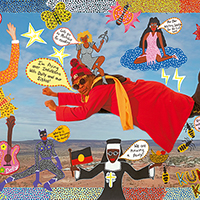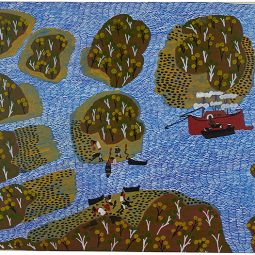“. . . experimentation with surrealist imagery
and innovative photographic techniques”
“The monographic survey of an artist’s work has its own importance and benefits, allowing us to see their development and growth across a career. But in thinking of that work in a different context – so showing it in conjunction with a peer or collaborator – allows wider insights, and reminds us that no art is made in a vacuum, no matter the discoveries made,” Heide Artistic Director Lesley Harding tells me about Man Ray and Max Dupain, which Harding curated with Emmanuelle de l’Ecotais – Ray historian and Artistic Director of Photo Days, Paris.

Max Dupain, Leon Gellert with mask, 1936, gelatin silver photograph, 39.5 × 30.3cm (image and sheet), 50.5 × 40.5cm (mount). National Portrait Gallery, Canberra. Gift Of Danina Dupain Anderson 2017, donated through the Australian Government’s Cultural Gifts Program
For the first time, the contemporaneous work of American-born artist Man Ray (1890–1976) and eminent Australian photographer Max Dupain (1911–92) are brought into dialogue in one exhibition. “In 2023,” Harding explains, “Heide presented the exhibition Surrealist Lee Miller, which touched on her productive collaboration with Man Ray in the early 1930s.
It spurred our idea to take a closer look at Man Ray’s output, which was last seen in detail in Australia more than twenty years ago in an exhibition co-curated by Judy Annear and Emmanuelle de l’Ecotais.
“In bringing a large quantity of his work to Australia again it seemed relevant, if not important to present it in dialogue with the contemporaneous work of one of our own ground-breaking photographers, Max Dupain. The commonalities between the two artists’ works were deeper and more resonant than we imagined.”
Exploring the artists’ respective engagements with Surrealism, key works include Ray’s Noire et Blanche, 1926, and Larmes de Verre, 1932, alongside Dupain’s Solarised Hands and Flowers, c.1934 and Torso in the Sun, 1941; the artists’ respective collaborations with creative and romantic partners, Miller and Olive Cotton, also considered.
In all, over 200 prints feature, with subject matters spanning the nude, portraits and still life to advertising and fashion. To narrow the field, Harding says selection was kept to the period of the 1920s and ’30s, with a strong preference for the more technically experimental photographs by each artist and a thematic approach to display. “In hanging the exhibition,” Harding says, “we decided to intersperse the artists’ works and display them by theme rather than sequencing them chronologically, which we felt was a more interesting and dynamic way to view their approaches and ideas.”

Man Ray, Champs délicieux no. 5, 1922, printed 1980, gelatin silver photograph mounted on board, 22 × 17cm (image and sheet), 35 × 29.5cm (board). Private Collection, Paris
Ray’s ‘rayographs’ – camera-less images that blurred the boundary between abstraction and realism – were a key contribution to photography, and his transformative influence on Dupain is something already known. But the ‘first time side-by-side’ makes this exhibition special – with much potential for insight. “While Man Ray was 20 years older than Max Dupain,” Harding tells me, “in the 1930s they were contributing to the same international salon exhibitions and the same photography journals.
“Their proximity in terms of their imagery and technical experimentation was remarkably close during this time despite working on opposite sides of the world and without ever meeting each other. I think the exhibition shows just how pervasive the styles and ideas of modernism were, and how timely, responsive and current the contributions of Australian artists could be.”
Ray and Dupain’s experimentation with surrealist imagery and innovative photographic techniques are a focus here, but what’s most exciting is how these artists’ contribution is made clearer, indeed amplified – with a still-relevant edge – by being presented in dialogue.
“What has been gratifying for us as curators,” Harding says, “is that while some of these images are one hundred years old, many still have a strong sense of being exploratory and revelatory, and retained a remarkable currency and veracity. I think both the images of both artists are lifted and possibly better understood by being shown together.”
Dr Joseph Brennan is a Lambda Literary Award-nominated author based in Tropical North Queensland.
Heide Museum of Modern Art
6 August to 9 November 2025
Melbourne
Originally published in print – Art Almanac, August 2025 issue, pp. 26–28


